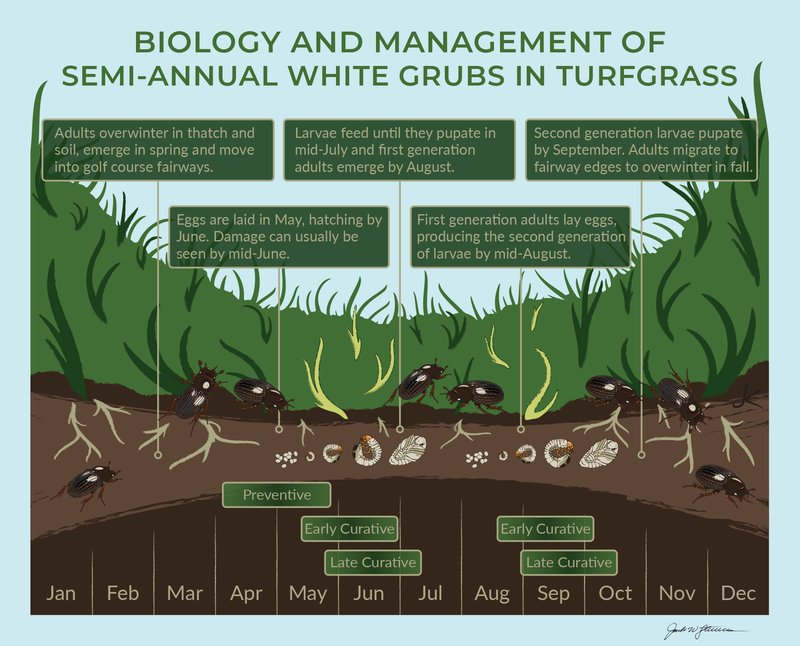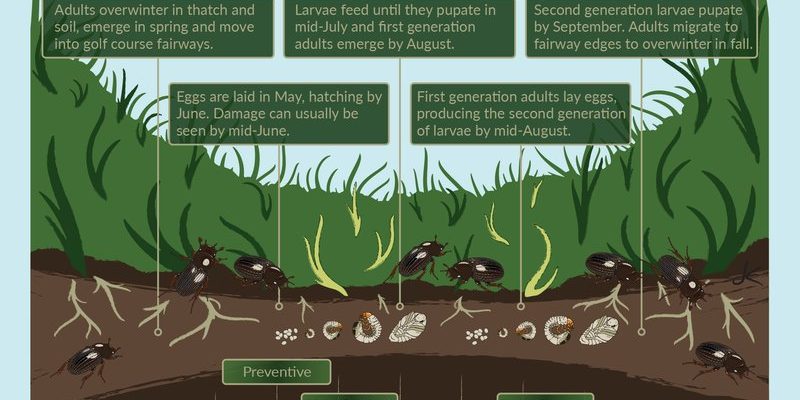
Imagine your lawn as a bustling city. The turfgrass blades are the high-rises, and the root systems are the infrastructure that supports them. If that infrastructure starts to crumble, the whole city feels the impact. That’s exactly what grub worms do—they munch on those vital roots, leading to potentially disastrous consequences for your lawn. Ready to dig deeper into this issue? Let’s explore how grub worms affect turfgrass root systems and what you can do about it.
What Are Grub Worms?
Grub worms are the larvae of beetles like the Japanese beetle and the European chafer, and they thrive in soil where grass grows. These larvae are usually white, C-shaped, and can grow up to 2 inches long. They feed primarily on grass roots, which might not sound like a big deal at first, but their eating habits can lead to significant problems for your turf.
You might be wondering why they are particularly attracted to your lawn. Well, grub worms find their way to healthy, thriving grass because it provides the perfect conditions for them to grow. The roots of the grass are plentiful food sources, allowing grubs to mature and develop into adult beetles. And once they’re adults? They’ll lay their eggs, and the cycle continues.
As if that weren’t enough, grub worms thrive in specific conditions such as moist soil and abundant grass cover. If you’ve had a wet spring or summer, your lawn could be a perfect breeding ground. So, it’s essential to keep an eye out for any signs that these little pests might be taking over.
How Grub Worms Damage Turfgrass Roots
Grub worms do their dirty work by feeding directly on grass roots, which leads to several issues. As they munch away, they disrupt the essential connection between the grass and the soil. This connection is vital for nutrient uptake, water supply, and overall plant health. Without healthy roots, grasses can’t access the resources they need to thrive.
When the roots are damaged, you might start to notice areas of your lawn turning brown or wilting. It can feel like a slow-motion disaster. The grass looks fine from a distance, but up close, the roots are compromised. If the grubs are numerous enough, large patches can die off completely.
Also, this damage can lead to other pests and diseases getting a foothold in your lawn. Just like in a city where the infrastructure fails, other problems start to appear. Poorly rooted turfgrass can become more susceptible to diseases, drought stress, and other pests, resulting in an ongoing battle for your lawn.
Signs of Grub Worm Infestation
If you suspect that grub worms may be causing trouble in your lawn, here are several signs to look out for:
- Brown Patches: Look for irregularly shaped brown areas that appear dry or dead.
- Grass Pull Test: Tug on the grass blades; if they come up easily with little or no root attachment, you might have grubs.
- Presence of Beetles: If you notice adult beetles flying around your lawn in the summer, it may indicate that grubs are lurking below.
- Birds or Animals: Spotting birds or animals digging in your lawn could signal the search for grubs.
Being proactive is key. If you notice these signs, it’s time for action! Ignoring a grub problem won’t make it go away.
Preventing Grub Worm Infestation
The best defense is a good offense. Here’s how to keep grub worms at bay before they become a problem for your turfgrass:
1. Healthy Lawn Practices: Focus on maintaining a thick, healthy lawn. Well-nourished grass is less attractive to grubs. Regularly fertilizing your lawn helps promote strong root systems.
2. Soil Aeration: Aerating your lawn allows air, water, and nutrients to penetrate the soil more effectively. This makes your grass healthier and less appealing to grubs.
3. Proper Watering: Water your lawn deeply but infrequently. This encourages deeper root growth and can make your grass less susceptible to grub damage.
4. Beneficial Nematodes: Consider introducing beneficial nematodes to your lawn. These microscopic worms feed on grubs and can help reduce their population naturally.
Each of these steps will not only help in preventing grub infestations but will also keep your lawn looking lush and vibrant.
Treatment Options for Infested Turf
If you’ve noticed a grub worm invasion in your lawn, don’t panic! There are effective treatments available:
1. Insecticides: Products containing ingredients like carbaryl or imidacloprid can treat grubs effectively. Be sure to follow the instructions carefully.
2. Natural Remedies: If you prefer to go the eco-friendly route, products with beneficial nematodes or milky spore can help control grub populations without harsh chemicals.
3. Timing is Key: Apply treatments when grubs are young, typically late summer to early fall. Timing your application maximizes effectiveness.
4. Regular Monitoring: Keep an eye on your lawn even after treatment. Looking for signs of grubs again can help you catch any new infestations early.
Grub worms don’t have to ruin your turfgrass’s appearance or health. With proper care and timely treatment, you can keep your lawn looking its best.
The Long-Term Impact of Grub Worms
Understanding how grub worms affect turfgrass root systems is essential for maintaining a healthy lawn over the long haul. The damage they cause can lead to poor growth, increased susceptibility to pests, and even the death of grass patches.
Ultimately, it’s a cycle that can spiral out of control without intervention. If you don’t address the grub issue now, you might be looking at years of patchy grass and ongoing battles against lawn diseases. Think of it as investing in your lawn’s future health—taking care of the problem today can save a lot of hassle down the road.
So, the next time you’re enjoying your lawn, remember the hidden battles beneath the surface. With proper care and awareness, you can keep your yard healthy, vibrant, and free from the clutches of grub worms.
In conclusion, staying informed and proactive is your best strategy against grub worms. Use the tips outlined here to strengthen your turfgrass’s defenses and keep those pesky grubs at bay. A healthy lawn isn’t just a pleasure to look at; it’s a testament to your care and investment in your outdoor space. Happy gardening!

